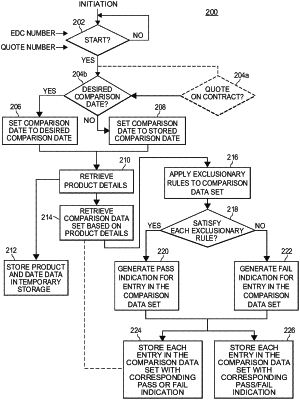| CPC G06Q 30/0206 (2013.01) [G06F 16/2379 (2019.01); G06N 3/045 (2023.01); G06N 3/08 (2013.01); G06Q 10/10 (2013.01); G06Q 30/04 (2013.01)] | 20 Claims |

|
1. A method for determining a set of lowest corresponding price data related to a salable unit, executed by at least one processor of a computer, comprising:
receiving an input indicative of the salable unit, the input including a current date;
generating a set of comparable salable unit data based on the input, wherein each respective comparable salable unit data in the set of comparable salable unit data includes a respective prior date within a date threshold from the current date;
storing the set of comparable salable unit data in a temporary storage table;
accessing the temporary storage table to determine the set of lowest corresponding price data by applying an exclusion model to the set of comparable salable unit data, wherein the exclusion model is a machine learning model trained with (i) a set of prior inputs, (ii) a set of prior comparable salable unit data, and (iii) a set of prior lowest corresponding price data and is configured to output the set of lowest corresponding price data;
responsive to determining the set of lowest corresponding price data, wiping the set of comparable salable unit data from the temporary storage table;
transmitting a notification of the set of lowest corresponding price data for display to a user, the notification indicating a lowest corresponding price for each lowest corresponding price data;
storing the set of lowest corresponding price data into an historical transaction log;
determining whether an invoice reporting table includes an anomalous entry by:
comparing each entry in the invoice reporting table with the historical transaction log, and
determining a respective entry in the invoice reporting table that does not have a corresponding set of lowest corresponding price data in the historical transaction log is the anomalous entry;
responsive to determining that the invoice reporting table includes the anomalous entry, transmitting a notification to a user indicating the anomalous entry; and
periodically updating the exclusion model by:
retrieving entries from the historical transaction log and corresponding entries from the invoice reporting table,
comparing the entries from the historical transaction log with the corresponding entries from the invoice reporting table, and
training the exclusion model using each entry from the historical transaction log that does not satisfy a confidence threshold when analyzed in tandem with at least one corresponding entry—from the invoice reporting table as inputs to output a subsequent set of lowest corresponding price data.
|